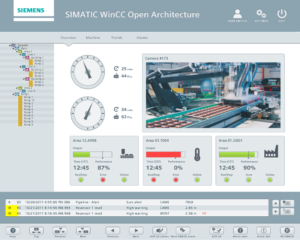Skip to content
WinCC Open Architecture Eğitimi (5 Gün)

- Architecture
- Client-server-system
- Functional separation into several processes (managers)
- Load distribution on several computers
- Redundancy (Hot Standby)
- Disaster Recovery System
- Multi-server – distributed systems up to 2048 systems
- Heterogeneous operating systems and version distribution
- Multi-monitor operation
- Multi-login on one workstation
- Multi-user system
- Event orientated process
- Internal message compression
- Safety functions to increase reliability (overload detection and regulation, query restrictions) Alarm system
- VDI 3699 / DIN 19235
- Freely definable alarm classes with 255 different priorities and definition of alarm colors (blinking)
- Standard, discrete and multiinstance alarms
- Up to 255 analog alarm ranges
- Summary alarms
- Automatic filtering of alarms (Handling of alarm floods)
- Panel hierarchy summary alarms
- Combined alarm- and event screen, alarm row with definable column set and colors and advanced sorting and filtering
- Storable configurations
- Direct access to the associated process window
- Comments and attended values on alarms
- Online change of alarm classes Process interfaces / drivers
- Event driven or cyclic polling
- Several different drivers at the same time on one server
- Periphery time stamps
- TCP/IP: SIMATIC S7, Modbus, Ethernet/IP, SNMP Manager & Agent, BACnet
- OPC: OPC Client & Server (DA, A&E), OPC UA Client & Server (DA, AC)
- Tele control / RTU: SSI, IEC 60870-5-101, -104, DNP3 and SINAUT, IEC 61850/61400
- Additional drivers on request or with a C++ API Data model
- Object oriented data model with freely definable and easy configurable structure
- Many standard objects included
- Modeling of technological objects in any hierarchy
- User definable tree structure
- Several different properties definable on elements
- Type-in-type (referencing)
- Inheritance
- Groups
- Generate different views on the data model Engineering environment
- Graphical editor
- Project hierarchy editor (Panel topology)
- Project editor
- Database editor
- Control programming editor, Script Wizard
- Mass data engineering and ASCII in / out manager
- Integration of external version management tools (CVS, SVN,…)
- Simple symbols, EWOs, Stylesheets
- Framework for engineering- & application user interfaces





